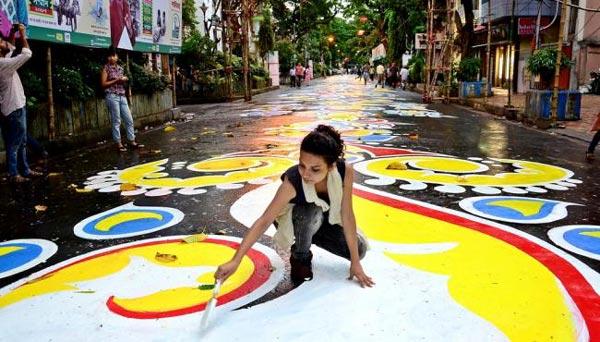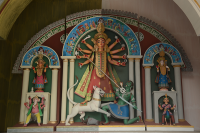 image
image
Beauty on the floor
Get floored, literally, by the beauty and craftsmanship of the traditional alpana art of Bengal, which is getting a new life during public festivities like puja, and even during the recent U-17 FIFA World Cup, writes Uttara Gangopadhyay
No matter how amiably we lived round the year – ‘we’ meaning cousins of school going age – battle lines would be drawn on the days of the annual Saraswati and Lakshmi puja. Who would draw the best ‘alpana’ in front of the goddess? To keep us from fighting, our grandmother would apportion different corners to us in her thakur ghor (prayer room) which also doubled up as the temporary seat of Goddess Saraswati or Lakshmi for their respective day-long festival , so that each one could draw his or her version of the alpana. By the time the priest arrived, the entire floor would be covered in geometric and floral patterns, executed by childish hands.
This childhood memory rushed back to mind recently while watching scores of art-college students kneeling on the ground and drawing a huge ‘alpana’ on the surface of a street in Kolkata at the start of Durga Puja. Although an adaptation of the original ‘alpana’, the complete work was a pretty sight that was soon doing the rounds of social media. Kolkata witnessed again at the Salt Lake Stadium during the Under-17 FIFA World Cup football the city hosted.
Drawing auspicious motifs, especially on the floor, is a practice seen across India among various communities. Called Rangoli, Kolam, Aripana, Mandna, etc., together they form a part of the folk art genre, which preserves within a combination of religious, aesthetic and social expression.
.jpg)
Alpana (or ‘alpona’) is the traditional, ritualistic floor drawing, popular in Bengal. Usually, it is drawn during auspicious occasions, such as Hindu religious festivals and social occasions (barring funerary ceremonies). Although there is no recorded history of alpana, it is said that the word is derived from the Sanskrit word alimpan.
Traditionally, the drawing is done by women, using a water-based paste made from uncooked rice kernel of unprocessed sun-dried paddy, called ‘atop chaal’. Tiny pieces of clean cotton cloth or cotton ball is dipped in the paste and held in between the fingers. It is then pressed to release the liquid to draw the pattern with the finger. In its simplest form, the alpana is a freehand drawing, a mix of hollow and solid patterns drawn using lines, circles, etc. to create ornamental or geometrical shapes. Then there can be representational motifs of trees, flowers, water bodies, animals, etc.
The traditional alpana in Bengal is invariably white in colour.
As an auspicious sign, the alpana is drawn on the floor where the religious ceremony or a social function may take place, along the entrance to the house or to rooms, in the courtyard, etc. Interestingly, the alpana not only adds to the aestheticism of the occasion but can also be a record of social history.
During the autumnal Lakshmi Puja, the festival honouring the goddess of wealth, women not only draw ornamental patterns, motifs representing owls (the mount of the goddess), lotus, etc. but also rows of a pair of tiny feet with a wavy line in between. The wavy line is representative of the paddy stalk. For a traditionally agrarian society, a good harvest of paddy is considered wealth.
In Bengal, women are known to observe broto (or vratas it is known as in many parts of India) on various occasions. Some of these rituals require some particular alpana. The ‘Bhaduli’ broto is observed post monsoon. In the bygone days, travelling great distances was a dangerous task, more so during and after the rains. So after the monsoon was over, the women would pray for the safe return of their menfolk. One of the key features of Bhaduli broto is drawing a series of alpana, with motifs symbolising boats, rivers, seas, dangerous animals, thorny bushes, etc., anything that would pose a risk for the people returning home. The women hold a flower over each motif and pray that their family members return safe.
.jpg)
Or take the ‘Punyipukur’ broto, where a waterbody is the main motif. Held at the start of the summer, the women pray that the ponds and rivers, which provide water for the agricultural fields and daily necessities remain full. In rural Bengal, ‘nabanna’ is a big festival, marking the harvesting season. So women draw elaborate alpana around the granaries where the paddy will be stored.
Like any other folk art form, there is no formal training for drawing alpana. It is a tradition that has been passed on from one generation of women to the next. Although much later one could find albums containing intricate motifs for alpana being sold at the Calcutta Book Fair.
Unfortunately with urbanisation setting in, the alpana, like many other traditional aspects, has taken a back seat. Besides, the concept of colourful Rangoli has also influenced the alpana, and it may not be only-white anymore. Few people are interested in the back-breaking and time-consuming task of drawing the motifs with cotton ball brush. So use of paint brushes and commercial colours have crept in. Nowadays, many urban homes prefer to buy the sticker sheets with intricate designs and use them in the place of hand-drawn alpana.
While the concept of alpana is still largely enmeshed in religious sentiments, Shantiniketan – the place coloured by the memories of Rabindranath Tagore – was the first to liberalise it. Students of Shantiniketan still draw elaborate alpana during their social functions and festivals.
Neighbouring Bangladesh took it further when they introduced it as a secular art to observe public functions. The finesse of the colourful and elaborate alpana across the roads during ‘Ekushey’ celebration (February 21, when Bangladesh observes it as the Mother Language Day) celebration has to be seen to be believed. The alpana drawing is also an integral part of the traditional New Year’s Day celebration in the capital city of Dhaka.
Kolkata’s maiden street alpana venture has now set the trend in West Bengal too. The feat was repeated in front of the city’s Vivekananda Yuba Bharati Krirangan (stadium) prior to the final rounds of the Under-17 FIFA World Cup football matches recently. Local artists from Fulia, a town in Nadia district, better known for its handwoven cotton textile, drew a two and half kilometre long alpana on the road, on the final day of the recently concluded Jagadhhatri Puja.
While alpana as street art has given a new twist to the traditional art form, it is also necessary to preserve the original art form. INTACH and Daricha Foundation have joined hands to revive the alpana as part of its efforts to preserve the folk arts of India, according to media reports. Rabi Biswas of Nadia, who initially learned the art from his grandmother, is also researching on the subject and has been collecting the motifs associated with the ‘broto’ observations. With efforts such as these, one can only hope that this traditional folk art form will not be lost for posterity.
Top Headlines
-
Art and Culture
Beyond Old and New: Bickram Ghosh and the Art of Fusion at Serendipity
December 25, 2025
-
Art and Culture
Saptak Music School of Pittsburgh hosts spellbinding evening of Indian classical music
September 23, 2025
-
Art and Culture
Zigzag to clarity: Sonal Mansinghs dance of life captivates Delhi
September 08, 2025
-
Art and Culture
USA: Santoor Ashram Kolkata mesmerises Los Angeles with a celebration of Indian classical music
August 27, 2025
-
Art and Culture
'Feels like a tonic in my musical pursuits': Flute virtuoso Pandit Ronu Majumdar receives Padma Shri
June 06, 2025
-
Art and Culture
Of Paris, a chronic pain and a pivotal friendship: Frida Kahlo meets Mary Reynolds at the Art Institute of Chicago
April 16, 2025
-
Art and Culture
Prabha Khaitan Foundation celebrates 'Vasant Utsav' at Indian Museum Kolkata
March 15, 2025
-
Art and Culture
Musical concert 'Ami Bhalobashi Bangla Ke' to be held in Kolkata on April 19
February 20, 2025
-
Art and Culture
A kiss in front of The Kiss? Vienna museum's V-Day offer is ode to Klimt's artistic masterpiece
February 10, 2025
-
Art and Culture
Dalhousie Square: Timekeeping with Kolkata's British gems
January 12, 2025

